Degenerative Disorders
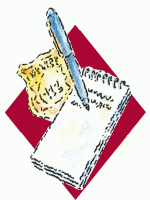 Just the facts
Just the factsIn this chapter, you’ll learn:
♦ disorders that diminish coronary blood flow and cardiac function
♦ pathophysiology and treatments related to these disorders
♦ diagnostic tests, assessment findings, and nursing interventions for each disorder.
A look at degenerative disorders
Degenerative disorders, which cause damage over time, are the most common cardiovascular ailments. The onset of these disorders may be insidious, triggering symptoms only after the disease has progressed. Degenerative cardiac disorders include acute coronary syndromes, cardiomyopathy, heart failure, hypertension, and pulmonary hypertension.
Acute coronary syndromes
Patients with acute coronary syndromes have some degree of coronary artery occlusion. Depending on the degree of occlusion, the syndrome is defined as unstable angina, ST-segment elevation myocardial infarction (STEMI), or non-ST-segment elevation myocardial infarction (NSTEMI).
Plaque’s place
The development of any acute coronary syndrome begins with a rupture or erosion of plaque—an unstable and lipid-rich substance. The rupture results in platelet adhesions, fibrin clot formation, and activation of thrombin.
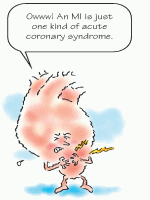 |
What you want to avoid
Complications of acute coronary syndromes include heart failure, chronic chest pain, chronic activity intolerance, and death.
What causes it
Patients with certain risk factors appear to face a greater likelihood of developing an acute coronary syndrome. These factors include:
• family history of heart disease
• obesity
• smoking
• high-fat, high-carbohydrate diet
• hyperlipoproteinemia
• sedentary lifestyle
• menopause
• stress
• diabetes
• hypertension.
How it happens
An acute coronary syndrome most commonly results when plaque ruptures inside a coronary artery and a resulting thrombus occludes blood flow. (A plaque deposit in a coronary artery doesn’t necessarily block blood flow significantly.) The effect is an imbalance in myocardial oxygen supply and demand.
The two Ds
The degree and duration of blockage dictate the type of ischemia or infarct that occurs:
• If the patient has unstable angina, a thrombus partially occludes a coronary vessel. This thrombus is full of platelets. The partially occluded vessel may have distal microthrombi that cause necrosis in some myocytes. The patient typically experiences symptoms.
• STEMI results when reduced blood flow through one of the coronary arteries causes myocardial ischemia, injury, and necrosis. The damage extends through all myocardial layers.
• If smaller vessels infarct, the patient is at higher risk for myocardial infarction (MI), which may progress to an NSTEMI. Usually, only the innermost layer of the heart is damaged.
What to look for
A patient with angina typically experiences:
• burning
• squeezing
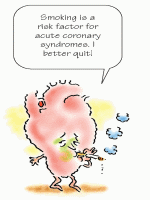 |
Atypical chest pain in women
Women with coronary artery disease may experience classic chest pain, which may occur without any relationship to activity or stress. However, they also commonly experience atypical chest pain, vague chest pain, or a lack of chest pain.
Location, location, location
Whereas men tend to complain of crushing pain in the center of the chest, women are more likely to experience arm or shoulder pain; jaw, neck, or throat pain; toothache; back pain; or pain under the breastbone or in the stomach.
Other signs and symptoms women may experience include nausea or dizziness; shortness of breath; unexplained anxiety, weakness, or fatigue; palpitations; cold sweat; or paleness.
• crushing tightness in the substernal or precordial chest that may radiate to the left arm, neck, jaw, or shoulder blade
• dyspnea or shortness of breath.
Any patient may experience atypical chest pain, but it’s more common in women. (See Atypical chest pain in women.)
It hurts when I do this
Angina most frequently follows physical exertion but may also follow emotional excitement, exposure to cold, or a large meal. Angina symptoms may be relieved by nitroglycerin. It’s less severe and shorter lived than the pain of acute MI.
Four forms
Angina has four major forms:
My, my, MI pain
A patient with MI may experience severe, persistent chest pain that isn’t relieved by rest or sublingual nitroglycerin. The patient may describe the pain as pressure, crushing, or squeezing.
The pain is usually substernal but may radiate to the left arm, jaw, neck, or shoulder blades.
The pain is usually substernal but may radiate to the left arm, jaw, neck, or shoulder blades.
 |
And many more
Other signs and symptoms of MI include:
• a feeling of impending doom
• fatigue
• nausea and vomiting
• shortness of breath
• cool extremities
• perspiration
• anxiety
• hypotension or hypertension
• palpable precordial pulse
• muffled heart sounds
• pallor or cyanosis.
What tests tell you
These tests are used to diagnose acute coronary syndromes:
• Electrocardiography (ECG) during an anginal episode may show ischemia. Serial 12-lead ECGs may be normal or inconclusive during the first few hours after an MI. Abnormalities include serial ST-segment depression in an NSTEMI, and ST-segment elevation and Q waves, representing scarring and necrosis, in a STEMI. (See Pinpointing infarction.)
• Coronary angiography reveals coronary artery stenosis or occlusion and collateral circulation and shows the condition of the arteries beyond the narrowing.
• Myocardial perfusion imaging with thallium-201 during treadmill exercise discloses ischemic areas of the myocardium, visualized as “cold spots.”
• With MI, serial serum cardiac marker measurements show elevated creatine kinase (CK), especially the CK-MB isoenzyme (the cardiac muscle fraction of CK), troponin T and I, and myoglobin.
• With a STEMI, echocardiography shows ventricular wall dyskinesia.
How it’s treated
For patients with angina, the goal of treatment is to reduce myocardial oxygen demand or increase oxygen supply.
These treatments are used to manage angina:
• Nitrates reduce myocardial oxygen consumption.
• Beta-adrenergic blockers may be administered to reduce the workload and oxygen demands of the heart.
• If angina is caused by coronary artery spasm, calcium channel blockers may be given.
 Now I get it!
Now I get it!Pinpointing infarction
The site of myocardial infarction (MI) depends on the vessels involved:
• Occlusion of the circumflex branch of the left coronary artery causes a lateral wall infarction.
• Occlusion of the anterior descending branch of the left coronary artery leads to an anterior wall infarction.
• True posterior or inferior wall infarctions generally result from occlusion of the right coronary artery or one of its branches.
• Right ventricular infarctions can also result from right coronary artery occlusion, can accompany inferior infarctions, and may cause right-sided heart failure.
• In an ST-segment elevation MI, tissue damage extends through all myocardial layers; in a non-ST-segment elevation MI, damage occurs only in the innermost layer.
• Antiplatelet drugs decrease platelet aggregation and the danger of coronary artery occlusion.
• Antilipemic drugs can reduce elevated serum cholesterol or triglyceride levels.
• Obstructive lesions may necessitate coronary artery bypass grafting (CABG) or percutaneous transluminal coronary angioplasty (PTCA). Other alternatives include laser angioplasty, minimally invasive surgery, rotational atherectomy, or stent placement.
• Enhanced external counterpulsation may be used to treat anginal pain when other therapies are unsuccessful.
MI relief
The goals of treatment for MI are to relieve pain, stabilize heart rhythm, revascularize the coronary artery, preserve myocardial tissue, and reduce cardiac workload.
Here are some guidelines for treatment:
• Emergency medical service providers or emergency department staff should give 160 to 325 mg of aspirin unless the patient has a history of aspirin allergy or signs of active or recent GI bleeding.
• Thrombolytics can be used within 3 hours of the onset of symptoms (unless contraindications exist). Thrombolytic therapy involves administration of streptokinase (Streptase), alteplase (Activase), or reteplase (Retavase).
• PTCA and stent placement is an option for opening blocked or narrowed arteries. Stents can be bare metal or coated with slow-releasing drugs that have been shown to improve long-term patency of the stent.
• Oxygen is administered to increase oxygenation of the blood.
• Nitroglycerin is administered sublingually to relieve chest pain, unless systolic blood pressure is less than 90 mm Hg or heart rate is less than 50 beats/minute or greater than 100 beats/minute.
• Morphine is administered as analgesia because pain stimulates the sympathetic nervous system, leading to an increase in heart rate and vasoconstriction. Additionally, morphine is a venodilator that reduces ventricular preload and oxygen requirements.
• Intravenous (IV) heparin is given to patients who have received tissue plasminogen activator to increase the chances of patency in the affected coronary artery.
• Physical activity is limited for the first 12 hours to reduce cardiac workload, thereby limiting the area of necrosis.
• Lidocaine, amiodarone (Pacerone), transcutaneous pacing patches (or a transvenous pacemaker), defibrillation, or epinephrine may be necessary if arrhythmias are present.
• IV nitroglycerin is administered for 24 to 48 hours in patients without hypotension, bradycardia, or excessive tachycardia to reduce afterload and preload and to relieve chest pain.
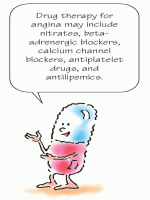 |
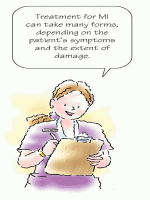 |
• Glycoprotein IIb/IIIa inhibitors (such as abciximab [ReoPro]) are administered to patients with continued unstable angina or acute chest pain to reduce platelet aggregation. They’re also administered after invasive cardiac procedures.
• An IV beta-adrenergic blocker is administered early to patients with evolving acute MI; it’s followed by oral therapy to reduce heart rate and contractility and to reduce myocardial oxygen requirements.
• Angiotensin-converting enzyme (ACE) inhibitors are administered to those with evolving MI with ST-segment elevation or left bundle-branch block to reduce afterload and preload and to prevent remodeling.
• Laser angioplasty, atherectomy, or stent placement may be initiated.
• Lipid-lowering drugs are administered to patients with elevated low-density lipoprotein and cholesterol levels.
• Cardiac surgery may be performed for emergencies that are unable to be addressed in the percutaneous intervention. CABG may restore blood flow to occluded arteries by sewing a patent vein or artery beyond the infarct site, thus restoring blood flow to the cardiac muscle.
What to do
• Collaborate care with a skilled team, which may include emergency medical personnel, a cardiologist, a cardiothoracic surgeon, a nutritionist, and a cardiac rehabilitation team.
• During anginal episodes, monitor blood pressure and heart rate. Take an ECG before administering nitroglycerin or other nitrates. Record the duration of pain, the amount of medication required to relieve it, and accompanying symptoms.
• On admission to the coronary care unit, monitor and record the patient’s ECG, blood pressure, temperature, and heart and breath sounds. Also, assess and record the severity, location, type, and duration of pain.
• Obtain a 12-lead ECG and assess heart rate and blood pressure when the patient experiences acute chest pain.
Status checks
• Monitor the patient’s hemodynamic status closely. Be alert for indicators suggesting decreased cardiac output, such as decreased blood pressure, increased heart rate, increased pulmonary artery pressure (PAP), increased pulmonary artery wedge pressure (PAWP), decreased cardiac output measurements, and decreased right atrial pressure.
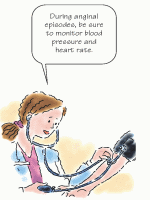 |
• Assess urine output hourly.
• Monitor the patient’s oxygen saturation levels, and notify the doctor if oxygen saturation falls below 90%.
• Check the patient’s blood pressure after giving nitroglycerin, especially after the first dose.
• Frequently monitor ECG rhythm strips to detect heart rate changes and arrhythmias.
Things heat up
• During episodes of chest pain, monitor ECG, blood pressure, and pulmonary artery (PA) catheter readings (if applicable) to determine changes.
• Obtain serial measurements of cardiac enzyme levels as ordered.
• Be aware that a serum B-type natriuretic peptide (BNP) assay may be ordered to determine if the patient is developing heart failure.
• Watch for crackles, cough, tachypnea, and edema—signs of impending left-sided heart failure. Carefully monitor daily weight, intake and output, respiratory rate, serum enzyme levels, ECG waveforms, and blood pressure. Auscultate for third or fourth heart sound (S3 or S4) gallops.
• Prepare the patient for reperfusion therapy as indicated.
• Administer and titrate medications as ordered. Avoid giving intramuscular (IM) injections; IV administration provides more rapid symptom relief.
• Organize patient care and activities to allow rest periods. If the patient is immobilized, turn him often and use intermittent compression devices. Gradually increase the patient’s activity level as tolerated.
• Provide a clear liquid diet until nausea subsides. Anticipate a possible order for a low-cholesterol, low-sodium diet without caffeine.
• Provide a stool softener to prevent straining during defecation.
Teach, review, document
• Teach the patient about signs and symptoms to report to the doctor.
• Review medications and their proper administration and possible adverse effects.
• Teach about risk factors and how to reduce them, as appropriate.
• Encourage family members to learn cardiopulmonary resuscitation.
• Document the patient’s response to treatment, vital signs, cardiac rhythm, episodes of pain and pain relief, and understanding of teaching.
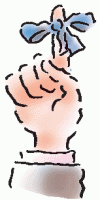 Memory jogger
Memory joggerThe American Heart Association’s acronym for saying goodbye to heart disease, ALOHA, can help you remember recommendations for your female patients who are at risk:
Assess your risk. Know important levels, such as cholesterol, weight, and blood pressure.
Lifestyle is the priority. Lifestyle changes such as smoking cessation, exercise, and a healthy diet can help prevent cardiovascular disease.
Other interventions may be necessary if lifestyle changes don’t significantly reduce the risk of heart disease. Consult with a physician.
High-risk cases are serious and need to be addressed immediately and consistently.
Avoid hormone therapy, antioxidant vitamin supplements, and aspirin therapy because these treatments may do more harm than good, especially in low-risk patients.
Cardiomyopathy
Cardiomyopathy generally refers to disease of the heart muscle fibers. It takes three main forms:
• dilated
• hypertrophic (obstructive and nonobstructive)
• restrictive (extremely rare).
Number two killer
Cardiomyopathy is the second most common direct cause of sudden death. (Coronary artery disease is first.) Because dilated cardiomyopathy usually isn’t diagnosed until its advanced stages, the prognosis is generally poor.
Other complications include heart failure, arrhythmias, hypoxemia, pulmonary edema, valvular dysfunction, hepatomegaly, and multiple-organ-dysfunction syndrome (MODS) resulting from low cardiac output.
What causes it
Risk factors for cardiomyopathy include previous MI, hypertension, pregnancy, viral infections, genetic predisposition, birth defects, certain cancer chemotherapy medications, and alcohol use. Overall, males and blacks of both sexes are at greatest risk. Restrictive cardiomyopathy, although rare, can be caused by autoimmune disease such as sarcoidosis or amyloidosis, chemotherapy or chest exposure to radiation for cancer treatment, and hemochromatosis (excess iron in blood).
How it happens
Most patients with cardiomyopathy have idiopathic, or primary, disease, but some cases are secondary to identifiable causes. Obstructive hypertrophic cardiomyopathy is almost always inherited as a non-sex-linked autosomal dominant trait.
Dilated cardiomyopathy
Dilated cardiomyopathy primarily affects systolic function. It results from extensively damaged myocardial muscle fibers. Consequently, contractility in the left ventricle decreases.
Poor compensation
As systolic function declines, stroke volume, ejection fraction, and cardiac output decrease. As end-diastolic volumes increase, pulmonary congestion may occur. The elevated end-diastolic volume is a compensatory response to preserve stroke volume despite a reduced ejection fraction.
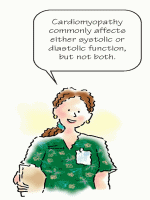 |
The sympathetic nervous system is stimulated to increase heart rate and contractility.
Kidneys kick in
The kidneys are stimulated to retain sodium and water to maintain cardiac output, and vasoconstriction occurs as the renin-angiotensin system is stimulated. When these compensatory mechanisms can no longer maintain cardiac output, the heart begins to fail.
Detrimental dilation
Left ventricular dilation occurs as venous return and systemic vascular resistance increase. Eventually, the atria also dilate because more work is required to pump blood into the full ventricles. Cardiomegaly is a consequence of dilation of the atria and ventricles. Blood pooling in the ventricles increases the risk of thrombus formation and emboli. Dilation of the left ventricle may lead to mitral valve dysfunction.
Hypertrophic cardiomyopathy
Hypertrophic cardiomyopathy primarily affects diastolic function. The features of hypertrophic cardiomyopathy include:
• asymmetrical left ventricular hypertrophy
• hypertrophy of the intraventricular septum (obstructive hypertrophic cardiomyopathy)
• rapid, forceful contractions of the left ventricle
• impaired relaxation
• obstruction of left ventricular outflow.
Fouled-up filling
The hypertrophied ventricle becomes stiff, noncompliant, and unable to relax during ventricular filling. Consequently, ventricular filling is reduced and left ventricular filling pressure rises, causing increases in left atrial and pulmonary venous pressures and leading to venous congestion and dyspnea.
Ventricular filling time is further reduced as a compensatory response to tachycardia. Reduced ventricular filling during diastole and obstruction of ventricular outflow lead to low cardiac output.
Hypertrophy hazards
If papillary muscles become hypertrophied and don’t close completely during contraction, mitral insufficiency occurs. Moreover, intramural coronary arteries are abnormally small and may not be sufficient to supply the hypertrophied muscle with enough blood and oxygen to meet the increased needs of the hyperdynamic muscle.
Restrictive cardiomyopathy
Restrictive cardiomyopathy is characterized by stiffness of the ventricle caused by left ventricular hypertrophy and endocardial fibrosis and thickening. The ability of the ventricle to relax and fill during diastole is reduced. Furthermore, the rigid myocardium fails to contract completely during systole. As a result, cardiac output decreases.
What to look for
Generally, for patients with dilated or restrictive cardiomyopathy, the onset is insidious. As the disease progresses, exacerbations and hospitalizations are common regardless of the type of cardiomyopathy.
Dilated cardiomyopathy
For a patient with dilated cardiomyopathy, signs and symptoms may be overlooked until left ventricular failure occurs. Be sure to evaluate the patient’s current condition and then compare it with his condition over the past 6 to 12 months.
Signs and symptoms of dilated cardiomyopathy may include:
• shortness of breath, orthopnea, dyspnea on exertion, paroxysmal nocturnal dyspnea, fatigue, and a dry cough at night due to left-sided heart failure
• peripheral edema, hepatomegaly, jugular vein distention, and weight gain caused by right-sided heart failure
• peripheral cyanosis
• tachycardia
• pansystolic murmur associated with mitral and tricuspid insufficiency
• S3 and S4 gallop murmurs
• irregular pulse, if atrial fibrillation exists
• fatigue and exercise intolerance
• hypotension with advanced disease.
Hypertrophic cardiomyopathy
Signs and symptoms vary widely among patients with hypertrophic cardiomyopathy. The presenting symptom is commonly syncope or sudden cardiac death. Other possible signs and symptoms include:
• angina
• dyspnea
• fatigue
• systolic ejection murmur along the left sternal border and apex
• peripheral pulse with a characteristic double impulse (pulsus bisferiens)
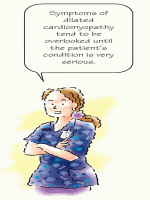 |
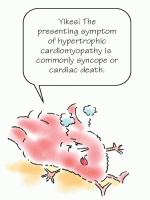 |
• abrupt arterial pulse
• irregular pulse with atrial fibrillation.
Restrictive cardiomyopathy
A patient with restrictive cardiomyopathy presents with signs of heart failure and other signs and symptoms, including:
• fatigue
• dyspnea
• orthopnea
• chest pain
• edema
• liver engorgement
• peripheral cyanosis
• pallor
• S3 or S4 gallop rhythms
• systolic murmurs.
What tests tell you
These tests are used to diagnose cardiomyopathy:
• Echocardiography confirms dilated cardiomyopathy.
• Chest X-ray may reveal cardiomegaly associated with any of the cardiomyopathies.
• Cardiac catheterization with possible heart biopsy can be definitive in diagnosing the causes of cardiomyopathy.
How it’s treated
There’s no known cure for cardiomyopathy. Treatment is individualized based on the type and cause of cardiomyopathy and the patient’s condition.
Dilated cardiomyopathy
For a patient with dilated cardiomyopathy, treatment may involve:
• management of the underlying cause, if known
• ACE inhibitors, as first-line therapy, to reduce afterload through vasodilation
• diuretics, taken with ACE inhibitors, to reduce fluid retention
• digoxin, for patients not responding to ACE inhibitors and diuretic therapy, to improve myocardial contractility
• beta-adrenergic blockers for patients with mild or moderate heart failure
• angiotensin II receptor blocker (ARB)
• calcium channel blockers to reduce blood pressure and afterload
• antiarrhythmics, such as amiodarone, used cautiously to control arrhythmias
• cardioversion to convert atrial fibrillation to sinus rhythm
• pacemaker insertion to correct arrhythmias
• biventricular pacemaker insertion to improve heart function by synchronizing atrial and ventricular contractions
• anticoagulants to reduce the risk of emboli (controversial)
• revascularization, such as CABG surgery, if dilated cardiomyopathy is due to ischemia
Stay updated, free articles. Join our Telegram channel

Full access? Get Clinical Tree






